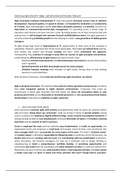Summary
Summary Project Management - all papers necessary for Information Management exam
- Course
- Institution
All .. papers for the Project Management: People and Technology exam for . This includes the following papers: - Embracing Agile (Darrell K. Rigby , Jeff Sutherland and Hirotaka Takeuchi) - No silver bullet (Brooks) - A spiral model of software development and enhancement (Boehm, TRW Defense System...
[Show more]



